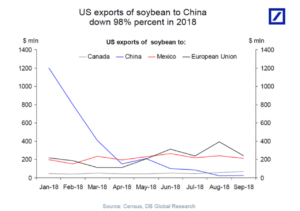All politics aside, the fact remains that the trade war implemented by our federal government is having a disastrous effect on agricultural exports.
 Our $14B in annual soybean sales to China has quickly fallen to $0 as of November of 2018. They’re now buying their soy from Brazil. With the Trans-Pacific Partnership agreement going into effect today, our ability to sell beef, pork, wheat and soy to Japan is going to be hampered due to trade discounts of 12% to 28%, which other countries will have, but we won’t.
Our $14B in annual soybean sales to China has quickly fallen to $0 as of November of 2018. They’re now buying their soy from Brazil. With the Trans-Pacific Partnership agreement going into effect today, our ability to sell beef, pork, wheat and soy to Japan is going to be hampered due to trade discounts of 12% to 28%, which other countries will have, but we won’t.
So, what happens to the farmers, wholesalers, transportation operators, marketers, etcetera, who grow, process, move and sell these commodities? What does this mean for farmers who are already financially stressed? Will we see another wave of family farms and rural businesses going bankrupt? Wil farmland go fallow and get swallowed up for other purposes? How long before the damage becomes a permanent drop in our ability to export agricultural products?
The government shutdown is not helping. It’s here at a time when most farmers are trying to plan and budget for the whole of next year. Financing for farmers is usually determined right now, but the USDA is closed for business and no one knows when it will open again.
Once the lack of exports and governmental assistance strains our agriculture system, how does that effect our domestic food sales? Will farmers be able to switch to other markets or will the financial strain be too great? How can farmers plan for next year when they don’t know what is going to happen next week?
There are just too many unknowns at this point. In this environment, how do farmers become more insulated from these market whims? Can we bring back a more local-based farm economy? What would that require: local processing, new distribution methods, new venues for retail? What crops would work best for this? How will climate change figure into all these other changes?
There are too many questions and too few answers right now.
Feb. 23, 2019 – Here’s a quick addendum to this post:
While agriculture bankruptcy rates across the US have remained steady, farms who regularly export to other countries are feeling the squeeze of our current tariffs. Bankruptcies across the upper Midwest have doubled since last year and are expected to skyrocket this year. See the Star Tribune’s reporting on this.
